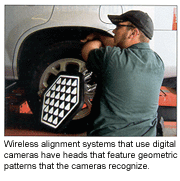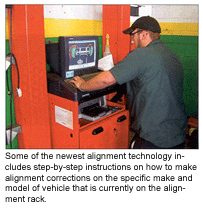Having the needed alignment specifications and service information close at hand is key to boosting productivity in today’s automotive service facilities. In the alignment bay, time is money. Combine this with the expense of today’s alignment equipment, and it’s easy to understand why choosing the right piece of alignment equipment is very important to an independent service facility.
Today’s technology advancements have also helped shrink the return on investment (ROI) window for alignment equipment. The technology has provided technicians with the ability to perform more alignments in the same amount of time. Technicians are also able to perform additional alignment inspections that can uncover needed chassis work that may have gone unnoticed and unperformed in the past.
 Thanks to technology that has been integrated into today’s alignment equipment, in addition to the necessary alignment specifications, technicians are provided with the information needed to make the adjustments, and are alerted to any special tools that are required and how long the needed repair should take. Some alignment equipment on the market can also calculate bushing and shim position, thus eliminating trial and error.
Thanks to technology that has been integrated into today’s alignment equipment, in addition to the necessary alignment specifications, technicians are provided with the information needed to make the adjustments, and are alerted to any special tools that are required and how long the needed repair should take. Some alignment equipment on the market can also calculate bushing and shim position, thus eliminating trial and error.
All the features found on today’s alignment equipment help simplify the alignment process. The newest technology includes instructional videos that can be shown right on the monitor of the alignment equipment. These videos provide step-by-step instructions on how to make alignment corrections on the specific vehicle currently on the alignment rack. Technicians no longer have to spend hours fumbling through service manuals in search of the correct alignment specifications for a given vehicle. The increase in reference data and service instructions make it possible for novice technicians to increase their service abilities and become alignment technicians.
Alignment equipment also can assist in providing complete and accurate estimates. Some alignment machines are equipped with color printers that come in handy when the technician or service writer is explaining needed alignment services to the vehicle owner. The causes of problems, such as uneven tire wear, vibration and other alignment related maladies, can be graphically presented to the vehicle owner in an easy-to-understand format.
Preventing Downtime
Damage to the heads is one of the leading causes for alignment equipment downtime. Wireless alignment systems eliminate the chance of wires being tripped over. Pushing technology one step further, some of the new alignment systems use digital cameras. The heads on these systems feature geometric patterns that the cameras mounted to the wall recognize. The alignment system can translate the pictures from the cameras into data that can be used to calculate alignment readings. Alignment systems that utilize camera systems can save shops time and money. When performing an alignment, set-up time is shorter because technicians no longer have to deal with wires or wireless transmitters. This time savings means additional alignments can be performed during the course of a day. In addition, this shorter set-up time provides shops with the ability to offer alignment checks for vehicles in the shop for other service for a small fee, or even free in some instances. This will result in needed service being uncovered while the vehicle is in the service bay.
While some people may view this increased technology as “just one more thing that can go wrong,” wireless alignment systems can be viewed as “one less thing that can go wrong.” The wheel-mounted targets are practically indestructible. Because they do not house any electronics, the occasional bump or drop by a technician will not damage their functionality. Shops not only save money on not having to replace broken sensors, the amount of equipment downtime is also diminished.
Training
Training is very important to the success of any service facility. When looking to purchase alignment equipment, the amount of training and manufacturer support are critical components of any alignment package. While technology found in today’s alignment equipment can assist any technician in becoming an alignment technician, it is still vitally important for shop personnel to be properly training on new pieces of equipment so they are able to realize the full potential of the technology found on the alignment machine.
 Some of today’s alignment equipment features instructional videos that can be viewed right on the equipment’s video monitor. Manufacturers may also have DVDs or CD-ROMs for technicians to view that will provide insights into the operation of the equipment.
Some of today’s alignment equipment features instructional videos that can be viewed right on the equipment’s video monitor. Manufacturers may also have DVDs or CD-ROMs for technicians to view that will provide insights into the operation of the equipment.
It is important to take advantage of all forms of training that are provided by the equipment manufacturer. While training may require technicians to miss some time in the shop, when they return, chances are they will be more productive and operate more efficiently, thus bringing more revenue into the shop.
When looking for alignment training for your technicians, look for courses that offer a balance between classroom time and hands-on experience in the shop setting. Technicians should be afforded the opportunity to use the alignment under real-world conditions. Many equipment manufacturers have regionalized training centers so technicians won’t have to travel across the country for classes. Don’t fall into the trap of only offering training for the technicians who will be using the equipment and who are senior members of your staff. Attending these types of classes is the perfect opportunity for some of your less experienced technicians to gain valuable hands-on practice.
Alignment equipment has made significant advancements the past few years. Owners of service facilities that are still using alignment equipment that was purchased in the 1980s, and even 1990s, need to take the time to explore the various alignment options available on the market today. The increase in productivity and profit provided by today’s alignment equipment can help any service facility better compete in today’s marketplace.




